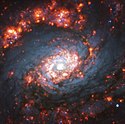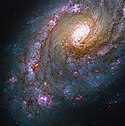NGC 5248
| Galaxie NGC 5248 | |
|---|---|
 | |
| Aufnahme mit einem 32-Inch-Teleskop | |
| AladinLite | |
| Sternbild | Bärenhüter |
| Position Äquinoktium: J2000.0, Epoche: J2000.0 | |
| Rektaszension | 13h 37m 32,024s[1] |
| Deklination | +08° 53′ 06,64″[1] |
| Erscheinungsbild | |
| Morphologischer Typ | (R)SB(rs)bc / Sy2 / HII[1] |
| Helligkeit (visuell) | 10,1 mag[2] |
| Helligkeit (B-Band) | 10,9 mag[2] |
| Winkelausdehnung | 6,2′ × 4,5′[2] |
| Positionswinkel | 122°[2] |
| Inklination | 40° |
| Flächenhelligkeit | 13,6 mag/arcmin²[2] |
| Physikalische Daten | |
| Rotverschiebung | 0.003839 ± 0.000002[1] |
| Radialgeschwindigkeit | (1151 ± 1) km/s[1] |
| Hubbledistanz H0 = 73 km/(s • Mpc) | (50 ± 4) · 106 Lj (15,4 ± 1,1) Mpc [1] |
| Durchmesser | 90.000 Lj[3] |
| Geschichte | |
| Entdeckung | Wilhelm Herschel |
| Entdeckungsdatum | 15. April 1784 |
| Katalogbezeichnungen | |
| NGC 5248 • UGC 8616 • PGC 48130 • CGCG 073-054 • MCG +02-35-015 • IRAS 13350+0908 • 2MASX J13373206+0853062 • GC 3615 • H I 34 • h 1650 • NVSS J133732+085309 • WISEA J133732.02+085306.9 | |
NGC 5248 ist eine aktive Balken-Spiralgalaxie mit ausgedehnten Sternentstehungsgebieten vom Hubble-Typ SBbc und liegt im Sternbild Bootes an der Grenze zum Sternbild Jungfrau. Sie ist schätzungsweise 50 Millionen Lichtjahre von der Milchstraße entfernt und hat einen Durchmesser von etwa 95.000 Lichtjahren.
Im selben Himmelsareal befindet sich u. a. die Galaxie IC 900.
Das Objekt wurde am 15. April 1784 von Wilhelm Herschel entdeckt.[4]
- Detaillierte Abbildung des Zentrums mittels Hubble-Weltraumteleskop
- Aufnahme verschiedener Spektralbereiche durch das Very Large Telescope
Literatur
- König, Michael & Binnewies, Stefan (2019): Bildatlas der Galaxien: Die Astrophysik hinter den Astrofotografien, Stuttgart: Kosmos, S. 159
Weblinks
Einzelnachweise
Auf dieser Seite verwendete Medien
Autor/Urheber: (Credit) ESO, Lizenz: CC BY 4.0
Rising from the ashes
Captured with the MUSE instrument mounted on ESO’s Very Large Telescope (VLT), this image shows the innermost regions of the distant spiral galaxy NGC 5248, also known as Caldwell 45.
Located around 59 million light-years away from Earth, in the constellation of Boötes, this galaxy is notable for having not one but two rings around its centre. These rings are characterised by “hot spots” of starburst activity. Starburst regions, seen as an orange glow in the picture, are where stars form much more frequently than usual.
MUSE, which stands for Multi Unit Spectroscopic Explorer, is attached to Yepun, one of the four 8.2-metre telescopes that make up the VLT. MUSE decomposes the light of every single pixel within its field of view into its constituent colours or wavelengths. This allows researchers to map complex mechanisms within extended objects, such as analysing the formation of stars in galaxies.
Credit:
ESO/TIMER survey
Coordinates Position (RA): 13 37 32.05 Position (Dec): 8° 53' 7.49" Field of view: 1.05 x 1.04 arcminutes Orientation: North is 0.0° right of vertical
Colours & filters Band Telescope Optical B 438 nm Very Large Telescope MUSE Optical G 475 nm Very Large Telescope MUSE Optical R 625 nm Very Large Telescope MUSE Optical N II 658 nm Very Large Telescope MUSE Optical H-alpha 656 nm Very Large Telescope MUSE.
Autor/Urheber: NASA Hubble Space Telescope, Lizenz: CC BY 2.0
Caldwell 45, or NGC 5248, is a spiral galaxy located in the constellation Boötes, and it is notable for the ring structure around its nucleus. These nuclear rings are characterized by “hot spots” of starburst activity. Starburst regions are sites where stars form at a much higher rate than usual. At a distance of 59 million light-years, the starburst regions in Caldwell 45 are actually some of the nearest to Earth and are less visually obstructed than many others.
Caldwell 45 was discovered by astronomer William Herschel in 1784. The galaxy has an apparent magnitude of 10 and can be spotted using a small telescope, though it won’t appear very bright.
A larger telescope is needed to make out the galaxy’s spiral arms. The best time of year to observe Caldwell 45 is during the Northern Hemisphere’s spring and the Southern Hemisphere’s autumn.
This stunning Hubble image of Caldwell 45 is a composite of observations made by the Wide Field Camera 3 and the Wide Field and Planetary Camera 2 in visible, infrared, and ultraviolet light. It captures the glowing red clouds where new stars are forming, scattered along the galaxy’s winding arms. These observations of Caldwell 45 were made to help astronomers learn more about gas in the galaxy’s starburst regions, as well as to better understand the structure of its nuclear rings.
Credit: NASA, ESA, and J. Lee (California Institute of Technology); Processing: Gladys Kober (NASA/Catholic University of America)
For Hubble's Caldwell catalog website and information on how to find these objects in the night sky, visit: <a href="https://www.nasa.gov/content/goddard/hubble-s-caldwell-catalog" rel="noreferrer nofollow">www.nasa.gov/content/goddard/hubble-s-caldwell-catalog</a>Autor/Urheber: Roberto Mura, Lizenz: CC BY-SA 3.0
Caldwell Catalogue objects.
Autor/Urheber: Credit Line and Copyright Adam Block/Mount Lemmon SkyCenter/University of Arizona, Lizenz: CC BY-SA 3.0 us
NGC 5248
Picture Details:
Optics 32-inch Schulman Telescope (RC Optical Systems) Camera SBIG STX CCD Camera Filters AstroDon Generation II Dates March 3rd and 4th 2011 Location Mount Lemmon SkyCenter Exposure LRGB = 170:70:70:70 minutes Acquisition ACP Observatory Control Software (DC-3 Dreams),TheSky (Software Bisque), Maxim DL/CCD (Cyanogen) Processing CCDStack (CCDWare), Photoshop CS3 (Adobe) Guest Astronomers: Walt LickteigCredit Line and Copyright Adam Block/Mount Lemmon SkyCenter/University of Arizona






